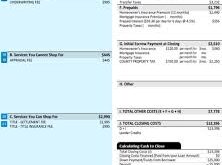Adjustable Mortgage Rates: Things Before Choosing One. Adjustable mortgage rates (ARMs) are home loan interest rates that fluctuate over time based on a predetermined index. Unlike fixed-rate mortgages, where interest remains constant, ARMs start with a lower initial rate that adjusts periodically.
How Adjustable Mortgage Rates Work
ARMs typically begin with an introductory period with a fixed interest rate, often for 3, 5, 7, or 10 years. After this period, the rate adjusts periodically, usually annually, based on an index such as the LIBOR, SOFR, or Treasury Bill Rate. The new rate is calculated by adding a margin to the index value.
Key Components of ARMs
- Initial Fixed Period – The time during which the interest rate remains unchanged.
- Adjustment Period – The frequency at which the rate changes after the fixed period ends.
- Index – A benchmark interest rate that determines future rate adjustments.
- Margin – A fixed percentage added to the index to calculate the new rate.
- Caps – Limits on how much the interest rate can increase in a single adjustment or over the life of the loan.
Pros and Cons of Adjustable Mortgage Rates
Pros
- Lower Initial Rates – ARMs offer lower interest rates compared to fixed-rate mortgages during the initial period.
- Potential Savings – If market rates decrease, borrowers could benefit from lower interest payments.
- Short-Term Homeownership – Ideal for buyers who plan to sell or refinance before the first adjustment.
- Qualification for Larger Loans – The lower initial payments allow borrowers to qualify for higher loan amounts.
Cons
- Uncertainty – Interest rates may rise, leading to higher monthly payments.
- Market Dependence – The adjustments depend on unpredictable market conditions.
- Complexity – ARMs involve multiple variables that can be difficult to understand.
- Potential for Payment Shock – Borrowers may face significant increases in monthly payments after the fixed period.
Types of Adjustable Mortgage Rates
- 3/1 ARM – Fixed for 3 years, adjusts annually afterward.
- 5/1 ARM – Fixed for 5 years, adjusts annually afterward.
- 7/1 ARM – Fixed for 7 years, adjusts annually afterward.
- 10/1 ARM – Fixed for 10 years, adjusts annually afterward.
- Hybrid ARMs – A combination of fixed and adjustable periods, offering flexibility.
Is an Adjustable Mortgage Rate Right for You?
ARMs are suitable for certain borrowers, including:
- Those planning to sell or refinance before the rate adjusts.
- Homebuyers expecting income growth in the future.
- Investors looking for lower initial payments to maximize returns.
How to Manage Rate Adjustments
- Understand Your Loan Terms – Read the fine print to understand how your loan will adjust.
- Monitor Market Trends – Keep track of interest rates to anticipate adjustments.
- Consider Refinancing – Switch to a fixed-rate mortgage before a major increase.
- Budget for Future Payments – Prepare for potential rate hikes by saving in advance.
- Use an ARM Calculator – Estimate potential payment changes using online tools.
10 Tips for Choosing an Adjustable Mortgage Rate
- Compare multiple lenders to find the best terms.
- Understand the index and margin your loan uses.
- Check rate caps to limit potential payment increases.
- Consider how long you plan to stay in the home.
- Calculate worst-case scenarios for payment hikes.
- Look for lenders offering interest rate locks.
- Review historical trends of the chosen index.
- Consult a mortgage advisor for expert guidance.
- Be aware of prepayment penalties.
- Ensure your budget can handle possible future increases.
10 FAQs About Adjustable Mortgage Rates
1. What happens when the fixed period ends? Your rate adjusts based on the index and margin set by your lender.
2. How often can my rate change? Usually annually after the initial fixed period.
3. Are ARMs better than fixed-rate mortgages? It depends on your financial situation and long-term plans.
4. Can I refinance an ARM into a fixed-rate mortgage? Yes, refinancing is an option to secure a stable rate.
5. What if interest rates drop? Your rate may decrease if the index goes down.
6. What are rate caps? Rate caps limit how much your interest rate can increase over time.
7. Are there prepayment penalties? Some lenders charge fees for paying off the loan early.
8. What is a hybrid ARM? A mortgage that starts with a fixed rate before switching to an adjustable one.
9. How do I calculate my new payment after an adjustment? Add the margin to the index rate and multiply by the loan balance.
10. Is an ARM a good choice for first-time homebuyers? It can be if they plan to sell or refinance before the adjustment period.
Conclusion
Adjustable mortgage rates offer flexibility and lower initial costs but come with the risk of payment increases. They are best suited for borrowers who plan to move or refinance before the rate adjustments begin. Before choosing an ARM, it’s essential to analyze your financial situation, understand loan terms, and prepare for potential fluctuations. By taking these precautions, you can maximize the benefits while minimizing risks associated with adjustable mortgage rates.
 mortgage.kbk.news
mortgage.kbk.news
